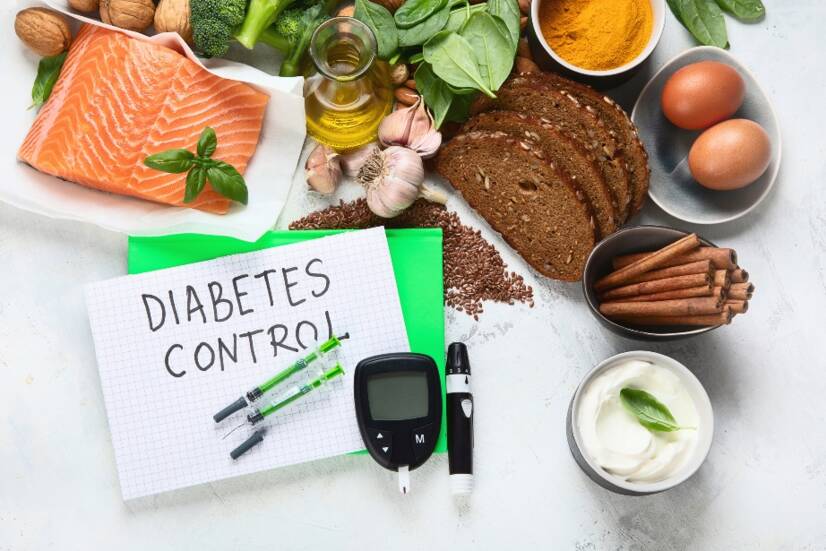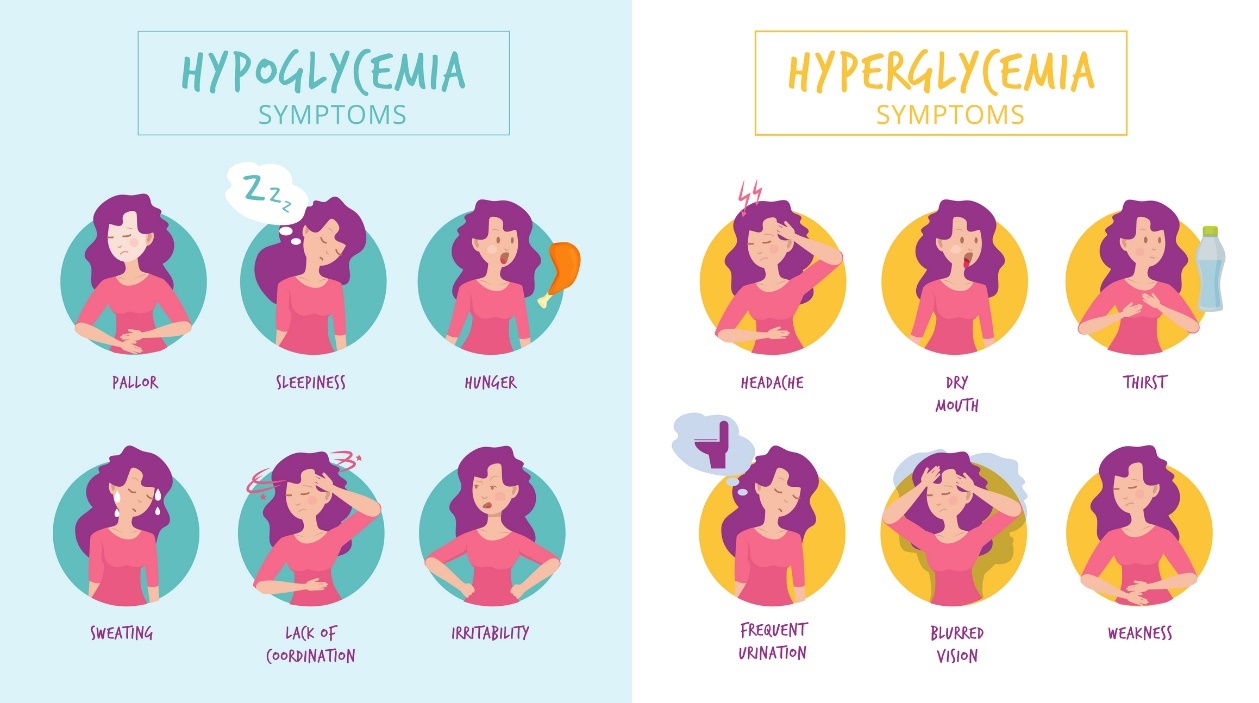- medicalnewstoday.com - What to know about type 2 diabetes and weight loss. Medical News Today. Michelle L. Griffith, MD
- solen.com - The importance of physical activity in the treatment of diabetes mellitus. solen. Marcela Szabó, MD et al.
- Healthline.com - The best diabetes-friendly diets to help you lose weight. Healthline. Kathy W. Warwick, R.D., CDE
- solen.com - Do patients with type 2 diabetes mellitus have to experience weight gain after starting insulin therapy? Solen. prof. MUDr. Jindřiška Perušičová, DrSc. et al.
How does diabetes affect body weight? Diabetes mellitus and lifestyle

Diabetes mellitus is a metabolic disease. Its main symptom is a lack of the hormone insulin, which is responsible for regulating blood sugar levels and its use. Can diabetes cause weight loss or weight gain?
Article content
Body weight and diabetes are closely related. The disease is influenced by an individual's body weight, diet and lifestyle. Weight management also depends on the exact type of diabetes.
Hyperglycemia/hypoglycemia, weight loss and weight gain in diabetes, lifestyle, diet and many other interesting information can be found in the article.
Diabetes mellitus and (sugar) metabolism
Glucose is a sugar which is one of the basic sources of energy for the human body. However, a hormone called insulin is needed to convert glucose into energy. This is produced in the pancreas - the pancreas.
Insulin is responsible for the metabolism of glucose (sugar) in the blood. It sends the sugar to the cells where it is then converted into energy. However, if insulin is deficient, the cells do not get the energy they need.
The sugar is not moved and accumulates in the blood. Hyperglycaemia results.
When there is a complete lack of insulin (type 1 DM) or when it has insufficient effect on the target tissues (type 2 DM), sugar is not moved into the cells and its level in the blood increases.
Prolonged high blood sugar levels can subsequently lead to a number of serious health problems.
Diabetes mellitus is divided by aetiology into:
- Type 1 diabetes mellitus (DM1).
- Type 2 diabetes mellitus (DM2).
Type 1 diabetes mellitus (DM2)
Type 1 diabetes occurs mainly in children and is therefore often called childhood diabetes. It is a chronic disease in which the insulin-producing B-cells of the pancreas stop working.
The body develops antibodies against its own cells. It is an autoimmune disease with insufficient secretion of the hormone insulin.
Type 2 diabetes mellitus
Type 2 diabetes mellitus is much more common. It occurs mostly in adulthood, but nowadays it also affects younger individuals.
DM2 is associated with higher body weight and an unhealthy lifestyle.
In most cases, DM2 is accompanied by elevated blood cholesterol, high blood pressure and metabolic syndrome.
In this type of diabetes, the body has a reduced sensitivity to insulin, which, unlike DM-1, is produced in excess. As a result of excess weight, the body's target tissues do not respond and are so-called less sensitive to the action of insulin.
Hyper/hypoglycaemia and symptoms in diabetes
Blood sugar levels fluctuate throughout the day in every individual. In healthy people, however, fasting blood glucose does not fall below 3.9 mmol/l and does not rise above 5.9 mmol/l.
Hypoglycaemia is a condition that occurs when blood glucose levels drop significantly. It is accompanied by cold sweat, pallor, shivering, palpitations and a change in mental state - nervousness, irritability or loss of attention.
Very high hyperglycaemia can lead to convulsions, loss of consciousness and even coma.
Blood sugar levels should be measured regularly and any signs of hypoglycaemia or hyperglycaemia should not be underestimated.
High glycemia has a bad effect on the body and leads to various health complications of late diabetes. Hyperglycemia is a risk factor for developing cardiovascular disease.
Read more in the article:
What health complications does diabetes cause? Even neglected and untreated
It manifests itself in increased thirst, nausea, fatigue, frequent urination or blurred vision.

How does diabetes affect weight?
DM1
Diabetes mellitus reduces the production of the hormone insulin. If cells cannot carry out energy conversion because of insulin, the body may think it is starving.
If the body is unable to transport glucose from the blood into the cells and use it for energy, it may find an alternative source of energy. It may use fat or muscle as an energy source.
The consequence is unintentional weight loss.
Sudden weight loss can be a sign of beginning unadjusted blood glucose levels. Although individuals with diabetes may lose weight suddenly, it is not the most common symptom.
It is most common in cases of type 1 diabetes. However, it can also occur in type 2 diabetes.
Symptoms of type 1 diabetes include initial sudden weight loss, weight loss, feeling thirsty and hungry, frequent urination, confusion, and the typical acetone mouth odor.
DM2
Being overweight is a significant risk factor for the development of type 2 diabetes. People with high weight and a high proportion of fat often also have higher levels of insulin resistance, which in turn can lead to type 2 diabetes.
Insulin resistance leads to higher insulin production, which increases the feeling of hunger and the subsequent risk of overeating. Insulin resistance can thus promote weight gain as the body tries to produce more and more insulin.
The weight number can also increase if insulin medication is taken.
If a person already suffers from insulin resistance, the actual weight loss process can be more difficult. Insulin affects the enzymes involved in fat storage. High insulin levels also cause frequent strong feelings of hunger.
Symptoms of type 2 diabetes include fatigue, hunger, thirst, tingling in the extremities, poorer wound healing, blurred vision, weight loss or weight gain.
Diabetes and lifestyle for weight management
The key to weight control and stability in diabetes is regular measurement of glycaemia and responding to measured deviations.
According to current recommendations, diabetics should follow a diabetic diet and lifestyle. This consists of regular daily glycaemic measurements, limiting sugar intake and performing regular physical activity to help improve tissue sensitivity to insulin.
It is necessary to regulate and maintain a healthy body weight. In type 2 diabetes, which is accompanied by overweight or obesity, it is necessary to reduce body weight. After assessment by a doctor, it is necessary to take medication to lower blood sugar levels - antidiabetic drugs.
The mainstay is lifelong treatment with insulin, which is painlessly injected (jabbed) just under the skin. Application is facilitated by insulin pens or an insulin pump, which can also monitor blood sugar levels so that insulin is available when needed.
Lifestyle and weight control in diabetes is related to:
- Regular blood sugar measurement (glucometer, sensor, pump).
- Good eating habits
- Regular physical activity
1. Measuring blood sugar levels
Glycaemia, the value of glucose in the blood is painlessly detected from 1 drop of blood from the finger using a glucometer. In addition to a regular glucometer, there are also subcutaneous sensors or an insulin pump.
Regular measurement and reaction to the measured deviations (insulin, glucagon, sugar...) is a prevention of health and weight management itself.
Read also:
Blood sugar levels: what is normal and what is hyper/hypoglycaemia?
2. Proper eating and diet
Appropriate selection and timing of meals is a common part of the diet and diabetes treatment plan.
It is advisable to consult a doctor and a nutritionist who will explain the basic rules of diet to the diabetic and calculate the necessary insulin dose. Diet is individual with regard to age, weight, food intolerances and health status.
For type 2 diabetes, diet and weight control are the keys to treatment.
Above all, it is about minimising the intake of simple sugars, replacing highly processed foods with healthier options. Attention is paid to the regularity of meals and the quality of food.
3. Appropriate regular physical activity
Regular physical activity helps to reduce insulin resistance and supports the cardiovascular system. Walking, swimming, weight training and yoga are suitable. Basically any activity that suits the diabetic.
Diabetes and diet
A diabetic should not completely exclude any of the three basic macronutrients - carbohydrates, fats or proteins - from their diet. However, some restriction of carbohydrates (sugars) is necessary.
Protein
Protein should be consumed at a rate of 1-1.5 g of protein per 1 kg of body weight. Of the proteins, you should focus on those that do not contain large amounts of fat.
Egg whites, lean meat (chicken), legumes and low-fat dairy products are suitable.
Fats
Unsaturated fats are recommended rather than saturated fats. For fats, it is advisable to focus on omega-3 fatty acids, which are found in fish, nuts, seeds, avocados, some cheeses, eggs or olive oil.
Carbohydrates
Sugars should be consumed in the diet in proportion to the glycaemic index of the food and should be rich in fibre. Complex carbohydrates, not fast sugars, should predominate in the diet of a diabetic.
The glycaemic index is a number that represents the position of a food on a scale from 0 to 100 based on how quickly the sugar in the food affects blood glucose levels.
Foods with a high glycemic index contain sugar that is absorbed quickly. Therefore, it significantly raises blood glucose levels.
This quickly leads to a feeling of hunger.
Consuming mostly slow-release carbohydrates is more beneficial to health because blood sugar levels are more stable. Therefore, within carbohydrates, eating legumes, whole grains, dark rice is appropriate.
Diabetics, however, must carry carry first aid in the form of a quick sugars in caseacute hypoglycaemiae.
Vegetables and fruits
Consumption of vegetables that are low on the glycaemic index and rich in essential nutrients is essential. Starchy vegetables such as peas, carrots or potatoes are also suitable to help maintain a healthy glycaemia.
Fruits, even if they contain fructose, should be part of a balanced diet for diabetics. Ideally, choose fruits with a low to medium glycemic index. Examples are bananas, blueberries, oranges, strawberries, grapes or kiwifruit.

Tips for diabetic diets:
- Eating smaller portions regularly
- Avoiding sweets and confectionery
- Limit sweetened beverages
- Whole wheat bread instead of white bread
- Brown rice instead of white
- Wholemeal pasta instead of white
- Adequate vegetable intake
- Adequate fibre intake
- Reduce alcohol intake
- Adequate protein intake
- Intake of unsaturated fats instead of saturated fats
- Avoiding semi-processed and highly processed foods
- Drinking enough clean water
What to avoid with diabetes?
- Excessive carbohydrate intake in general
- Sweets and confectionery
- Drinking sugar-sweetened beverages
- Sweetened dairy products
- Excessive intake of fatty foods
- Insufficient intake of vegetables
- White pastries
- Excessive intake of convenience foods
- Alcohol and smoking
- Strict crash diets and detoxification
- Insufficient drinking
Interesting resources
Related










